Alternative Approaches to Pancreatic Cancer: The medical applications of Turmeric, Huachansu and Cannabis
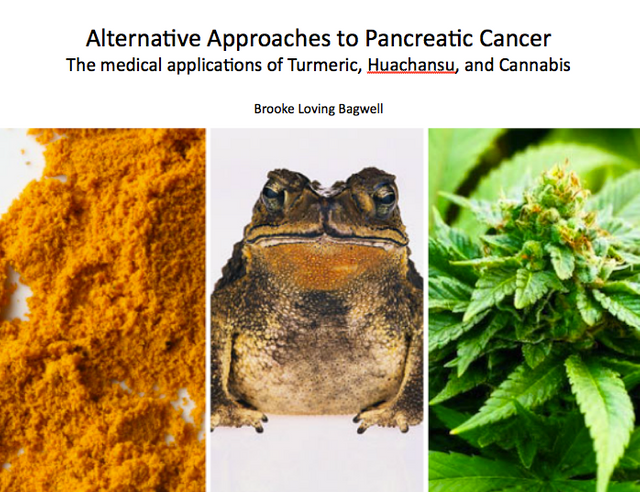
Good day friends!
I am passing along some of my research, with hopes that one of you out there will find this helpful.
When my mother was diagnosed with pancreatic cancer in 2013, I was made to feel powerless given her prognosis. And from this place, I indeed, gave my power and hope away to the oncologists, the drugs, and ultimately to her death.
In the months following, I suffered from overwhelming guilt for not doing more to help her. My guilt was self-destructive, but the knowledge I gained from the experience has changed my life. This is some of the research that has budded from the ashes.
I hope that this research offers hope for greater possibility and inspiration for taking back our power.
Thank you
Brooke

According to the American Cancer Society, an estimated 53,070 people in the U.S. will be diagnosed with pancreatic cancer in 2016.(1) Among them, an estimated 41,780 will die from pancreatic cancer.(1) With a one-year survival rate of 20% and a five-year survival rate of 5%, pancreatic cancer has been deemed largely incurable by Western medicine.(2) Pancreatic cancer’s low survival rate is largely attributed to a fast growth rate and common late diagnosis.(2) By the time that pancreatic cancer is detected in a patient, it is often too late for surgical removal.(2)
Conventional methods of treatment include surgical removal, radiation and chemotherapy, however the insidious nature of pancreatic cancer renders even the most technically advanced measures relatively futile. The Whipple Procedure—a complex surgery used for >15% of pancreatic patients who qualify—has a five-year survival rate of merely 25%.(3) The median survival rate for patients who underwent chemotherapy is 6-12 months respectively, and the role of radiation therapy for pancreatic cancer has yet to be clearly defined.(4,5)
This research presents three modalities (Ayurvedic Medicine, Traditional Chinese Medicine, and Western Medicine) through which to view the etiology and course of illness of pancreatic cancer. In addition, this article expands on the potentials of turmeric, Huachansu, and medical cannabis in treating pancreatic cancer.
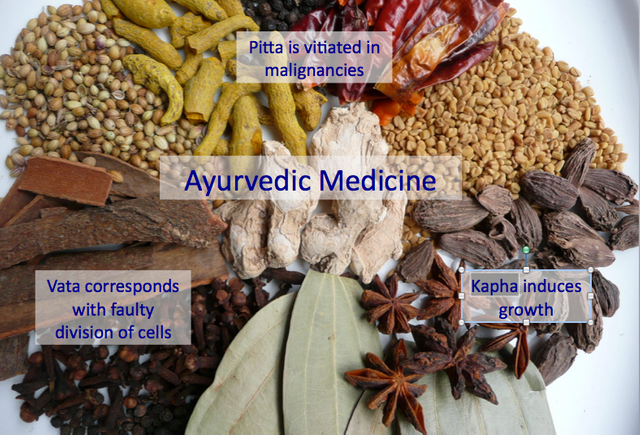
AYURVEDIC MEDICINE, Turmeric (Curcumin)
I. ETIOLOGY
In Ayurvedic medicine, one’s health is determined by the balance of their three doshas (Vata, Kapha, and Pitta).(6) When balanced, Vata, Kapha, and Pitta support a healthy immune system and enable communication among body systems. Health issues arise when the doshas become imbalanced.(6) Imbalance can arise from a long-standing improper lifestyle according to one’s body constitution, the environment, and the seasons, yet the subsequent suppression of the immune system is what induces cancer cell generation.(7)
Thus, one’s balance and overall health is reliant on a healthy immune response, believed to be controlled by 21 factors, including Baala (inherent strength), Ojas (proper metabolism resulting in an active distilled cellular nutrient extract), and Agni (digestive fire).(7) In addition, the presence of non-digested matter (Aama) in the bloodstream can further inhibit doshic function and exasperate the imbalance, leading to the deposit of external substances in one’s tissues and cells.(7)
II. COURSE OF ILLNESS
In Ayurveda, Cancers are particularly hard to treat because they tend to originate from an imbalance of all three doshas rather than just one—vata corresponds with the faulty division of cells, kapha induces growth, and pitta is vitiated in malignancies. Like most cancers, pancreatic cancer correlates with a Tridoshic (Vata, Kapha, Pitta) imbalance.(6) Under these conditions, the agni of the infected pancreas is increased, making it hostile to its surroundings as it gradually digests the tissues of the body.(7) Overtime, vata imbalance results in severe destruction of bodily tissues and the ojas in the pancreas decrease significantly.(7)
III. TREATMENT
Ayurvedic treatment of pancreatic cancer includes a vast variety of therapies and herbs to purify the body on the physical, mental and spiritual level and aid in natural recovery, yet their common purpose is to (re)balance the doshas to achieve optimal health.
On the physical plane, herbs are used to reduce tumor size and even limit metastasis. Turmeric, saffron, safflower, myrrh, manjistha (rubia cordifolia), bhumyamalaki (phyllanthus amarus), and yograj guggul (commiphora mukul) are just a handful of the herbs employed to stimulate circulation, remove obstructions, and promote recovery of the tissue.(6) Most notably, the active ingredient of turmeric, curcumin, has been found to reduce cell viability and stimulate morphological changes distinctive of cell death.(8)
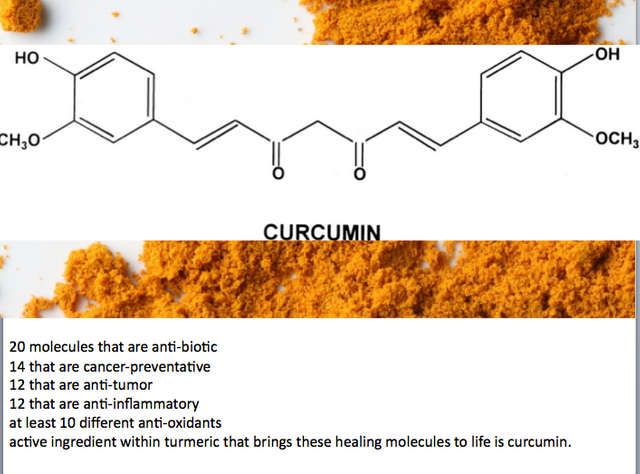
Used widely in Ayurveda, turmeric is revered for its anti-inflammatory, analgesic, anti-bacterial, anti-tumor, anti-allergic, anti-oxidant, antiseptic, antispasmodic, astringent, carminative, cholagogue, digestive, diuretic, stimulant, and vulnerary properties.(9) Thought to balance the tridoshas, Ayurvedic practitioners have used turmeric as an internal medicine via fresh juice, boiled tea, tinctures, or powder, and as a topical medicine using creams, ointments, pastes, and lotions.(9)
The molecular structure of turmeric is composed of hundreds of elements varying in biological properties. Turmeric is known to have at least 20 molecules that are anti-biotic, 14 that are cancer-preventative, 12 that are anti-tumor, 12 that are anti-inflammatory, and contain at least 10 different anti-oxidants.(9) The active ingredient within turmeric that brings these healing molecules to life is curcumin. Making up only 2-5% of raw turmeric, curcumin packs a powerful punch.(9) Ingested with black pepper (piperine), curcumin is made 2000 times more bio-available, initiating various transformative processes in the body.(9)
The role of curcumin in treating cancer has been heavily researched, leading researchers to point to three ways in which curcumin affects cancer: 1. curcumin counteracts against the substances that enable cancer to grow; 2. curcumin strengthens cells’ resistance to carcinogenic agents; and 3. curcumin actively attacks tumors.(9)

A phase I study investigating the safety and pharmacokinetics of highly bio-available curcumin (Theracumin) in cancer patients found curcumin to have no dose-limiting toxicity.(10) Instead, dosing was limited to the number of pills that patients would swallow per day.(10) Thus treatment of cancer through the daily oral intake of curcumin is permissible at any dosage, as high as 12g/day over three months as determined by one University of Texas study.(11)
Specific to pancreatic cancer, curcumin reduces cell viability by attacking the inhibitors of apoptosis such as IAP protein and MRNA expression in PANC-1 cells.(8) In addition, curcumin inhibits cyclooxygenase-2 (COX-2), an enzyme that promotes activity of carcinogens in the body and enables cancerous cells to survive through the production of new blood vessels.(12)
A phase II study of curcumin in 25 patients with advanced pancreatic cancer found curcumin to stabilize and/or decrease tumor growth in two of its patients.(13) Taking 8g of curcumin orally, every day, one patient stabilized their disease for >18 months; another had a brief tumor regression of 73% accompanied by a significant increase (4- to 35-fold) in serum cytokine levels.(13) No toxicities were observed.(13)
The same study that discovered the efficacy of curcumin in reducing IAP protein and MRNA expression in PANC-1 cells concluded that curcumin can serve as a useful mediator for overcoming chemotherapeutic resistance—an emerging trend among pancreatic cancer patients.(8) Their data supports curcumin as one therapeutic treatment for pancreatic cancer.(8)
Because curcumin does not have a dose-limiting toxicity, curcumin could be consumed orally, up to 12g/day. Two ways in which a patient with pancreatic cancer could consume curcumin are 1. combining turmeric spice with food or 2. supplement form. Given that the active ingredient of black pepper, piperine, increases the bio-availability of curcumin by 2000 times, it is advisable to add black pepper when cooking with turmeric and/or find a supplement that contains curcumin and piperine.(9)
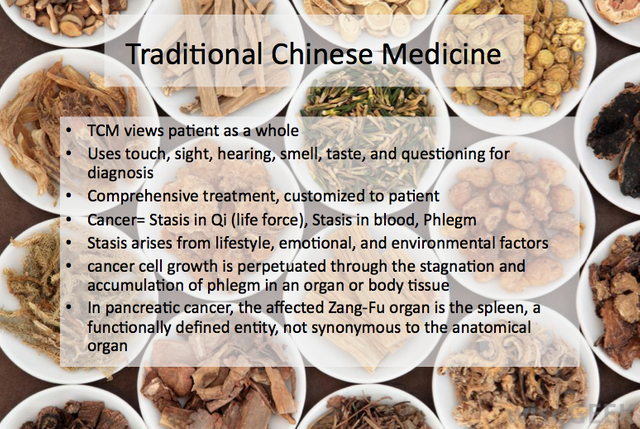
TRADITIONAL CHINESE MEDICINE, Huachansu (Cinobufagin)
I. ETIOLOGY
In evaluating illness, Traditional Chinese Medicine (TCM) views the patient as a whole with a regard to their symptoms. Using touch, sight, hearing, smell, and questioning for diagnosis, practitioners commonly rely on bodily indicators such as one’s tongue, eyes, skin color, complexion, even breath and urine for information.(14) Quite different from the homogenized treatment cancer patients receive in Western medicine, TCM practitioners create a comprehensive treatment that is customized to a patient’s symptoms.
Traditional Chinese Medicine recognizes cancer as a slowing or blockage in the flow of substances through the body.(15) Stasis in Qi (life energy force), stasis in the blood, and phlegm are all considered to be the underlying factors responsible for masses and abnormal cellular growth.(15) Stasis is believed to result from an array of factors, including emotional disharmony, improper diet and exercise, and external pathogenic agents’ Traditional Chinese Medicine’s attention to emotional imbalance is unique in that it points to depression (repressed anger), anxiety (worry, fearfulness, and overstimulation of the mind) and grief (following the death of a loved one) as sources of stagnation in one’s circulation.(16) In addition, the Chinese have long recognized environmental agents (toxins) as contributors in cancer development.(16) Prolonged stagnation of circulation greatly increases one’s chance of local accumulation, which can ultimately manifest as a tumor in weak organs or body tissue.(16)
II. COURSE OF ILLNESS
Gone undiagnosed, cancer cell growth is perpetuated through the stagnation and accumulation of phlegm in an organ or body tissue, which then metastasizes through the body and results in death. However, stagnation, accumulation, and progression can be abated through treatment.
Treatment begins with stasis diagnosis which involves examining signs, symptoms, and the Zang-Fu organs affected.(15) In the case of pancreatic cancer, the affected Zang-Fu organ is the spleen, a functionally defined entity, not synonymous to the anatomical organ.(17) The stasis is then examined in relation to the body’s energetics, the condition of Zang Fu, the substances (blockages), and one’s meridians.(15)
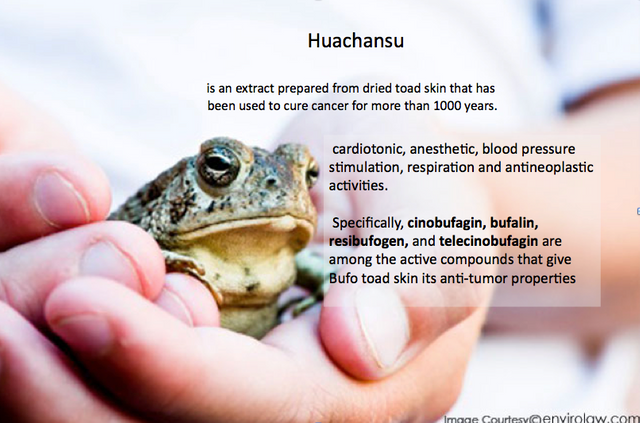
III. TREATMENT
Among the various TCM therapies employed to cure cancer, Huachansu is arguably one of the most astounding. Huachansu is an extract prepared from dried toad skin that has been used to cure cancer for more than 1000 years.(18) To make Huachansu, practitioners extract the venom excreted by the skin of the Bufo toad, dry it, and then dissolve it into water to create a medicinal liquid.(18) The liquid is then injected into cancerous areas to target cancer cells.(18)
Within Bufo toad skin, there are various bufadienolides (cardioactive steroids) that exhibit cardiotonic, anesthetic, blood pressure stimulation, respiration and antineoplastic activities.(19) Specifically, cinobufagin, bufalin, resibufogen, and telecinobufagin are among the active compounds that give Bufo toad skin its anti-tumor properties.(19)
A 2006 review of Huachansu points to numerous in vitro and in vivo datasets that have all suggested the anti-tumor activity of Huachansu and its active compounds, bufalin and cinobufagin.(20) The studies compiled within the 2006 review have found that bufalin and cinobufagin inhibit cell proliferation, induce cell separation, promote apoptosis, disrupt the cell cycle, inhibit cancer angiogenesis, reverse multi-drug resistance, and regulate the immune response.(20)
A pilot study testing the toxicity of Huachansu in patients with liver cancer, non-small-cell lung cancer, or pancreatic cancer found that no dose-limiting toxicities were observed with the use of Huachansu at doses up to eight times higher than the typical dosage used in China.(18) In fact, six of the fifteen patients had prolonged stable disease or minor tumor shrinkage.(18) In this study, Huachansu was administered to patients for 14 days consecutively, followed by 7 days off to complete one cycle.(18) Over the course of five cycles, the dosage of Huachansu increased from 10mL/m2 to 90 mL/m2.18 This study proves that Huachansu has no dose-limiting toxicities and can assist in stabilizing tumor growth.(18)
Another study that evaluated the efficacy and safety of using Huachansu in tandem with chemotherapy (gemcitabine) in patients with advanced pancreatic cancer found that Huachansu, when combined with gemcitabine, did not improve (nor harm) the outcome of patients with locally advanced and or metastatic pancreatic cancer.(21)
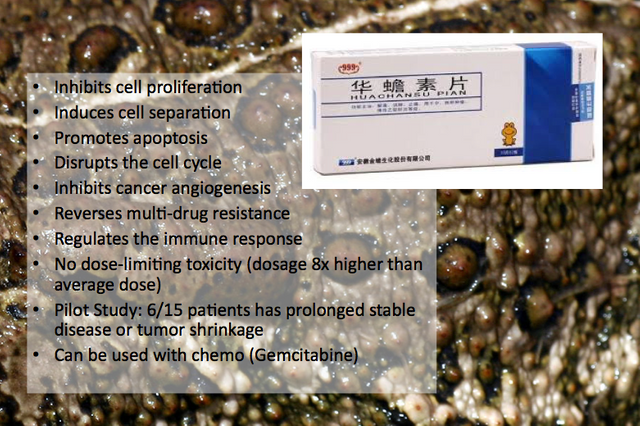
Given that Huachansu has no dose-limiting toxicities, a patient with pancreatic cancer could technically receive Huachansu injections, up to 90mL/m2 daily from a TCM practitioner.(18) However, it is important to note that TCM emphasizes the importance of a personalized regimen in order to address the patient as a whole. Thus, it is advisable to first consult with a TCM practitioner to determine the appropriateness of Huachansu therapy for one’s condition.
The great potential of Huachansu has attracted the attention of many Western practitioners. Currently, the MD Anderson Cancer Center in Houston, TX is collaborating with the Fudan University Cancer Center in Shanghai to carry out several independent Phase I and Phase II studies related to Huachansu.(22,23)
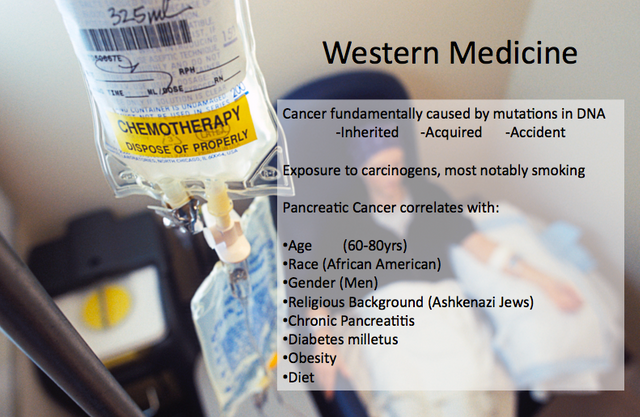
WESTERN MEDICINE, Medical Marijuana (Cannabidiol)
I. ETIOLOGY
According to Western Medicine, pancreatic cancer is fundamentally a disease caused by mutations to DNA.(24) These mutations can be inherited from our parents, acquired over time, or damaged on accident.(24) It is important to note that not all individuals with a genetic predisposition to cancer get cancer.(24) In fact, acquired damage to DNA is an equal culprit of pancreatic cancer; exposure to carcinogens greatly increase one’s risk of cancer.(24) Most noted among Western practitioners are the adverse effects of smoking cigarettes, believed to double one’s risk of pancreatic cancer.(24) Pancreatic cancer can also be acquired by mistake if the DNA copying machinery in a cell accidentally copies mutated DNA and damages an important cancer-associated gene in a cell in the pancreas.(24) Additional studies have found one’s propensity for pancreatic cancer to be correlated with age (between 60-80 years), race (African Americans), gender (men), and religious background (Ashkenazi Jews), as well as chronic pancreatitis, diabetes milletus, obesity and diet.(24)
II. COURSE OF ILLNESS
Due to the fact that pancreatic cancer grows rapidly and often detected late, it has a poor prognosis.(2) As pancreatic cancer advances, it can induce jaundice, pain, bowel obstruction, and weight loss.(2) According to the American Cancer Society, pancreatic cancer is still deemed largely incurable with a one-year survival rate of 20% and five year rate of 6%.(2) The low survival rates are most attributable to the rapid growth of pancreatic cancer, as less than 20% of patients’ tumors are solely confined to the pancreas upon diagnosis, making surgical removal impossible.(2)
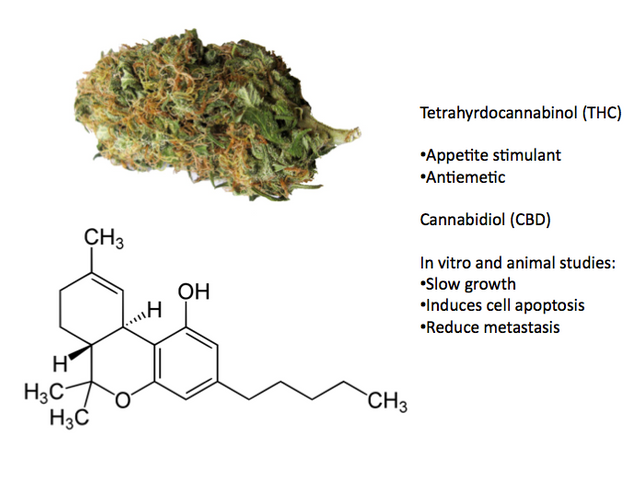
III. TREATMENT
Largely contested within the medical field is the use of medical marijuana (cannabis) in treating cancer. However, years before the legalization of medical cannabis, a 1991 Harvard Medical School study of 2000 oncologists found that 44% were recommending cannabis to their patients to mitigate nausea, pain, and other side effects from chemotherapy and radiation.(25)
Tetrahyrdocannabinol or THC is an active ingredient in cannabis, most often associated with the psychoactive component of cannabis, however it is also an appetite stimulant and antiemetic.(26) Tetrehydrocannibal has been used to treat nausea and vomiting caused by cancer medications, and today, is available in the form of a prevention pharmaceutical drug, Marinol, sold in the United States and Canada.(26) The second active ingredient in cannabis is Cannabidiol or CBD, which does not have a psychoactive effect. Cannabidiol has long been known for its anti-spasmodic, anti-epileptic, anti-anxiety, and anti-psychotic properties, however it is gaining attention for its effectiveness is treating cancer pain.(27)
Cannabinoids mediate their effects through pathways in the body known as receptors, comprised to make the endocannabinoid system. Specifically, cannabinoids interact with CB1 and CB2 receptors, mostly found in the brain and immune system, but also in other cells throughout the body.(28) Through interaction with CB1 and CB2, cannabinoids activate the receptors and alter the functioning of the body.(28) The CB1 receptors correlate with marijuana’s psychological effects in the brain, impacting memory, mood, sleep, appetite, and pain.(28) The CB2 receptors correlate with marijuana’s anti-inflammatory effects.(28) Thus cannabinoids can be used to mitigate inflammation in the body, a common attribute of cancer and other health conditions. Recent studies have identified the endocannabinoid system as a subject for further cancer research due to the fact that cancerous cells have been observed to exhibit higher levels of cannabinoid receptors.(29)
A 2006 study shows that cannabinoids induce apoptosis of pancreatic tumor cells in two different animal models of pancreatic cancer.(30) Cannabinoid administration was observed to 1. induce apoptosis, 2. increase ceramide levels, and 3. up-regulate mRNA levels of the stress protein p8 in MiaPaCa2 and Panc1 cell lines (in vitro).(30) Meanwhile, normal pancreatic cells were left untouched by the cannabinoids.(30) These effects occurred via activation of the CB2 receptor and present new evidence for the use of cannabinoids in treating cancer.(30)
In addition, the study discovered that cannabinoids inhibited the spreading of cancer to both nearby tissues, such as the spleen, and distant tissues such as the liver, diaphragm, stomach, and intestine.(30) These findings suggest that cannabinoid treatment could decrease pancreatic cancer metastasis, the principal culprit of pancreatic cancer death.(29)
A 2008 study established that cannabinoid receptors were up-regulated in human pancreatic cancer cells, suggesting that the endocannabinoid system may be increased in pancreatic cancer.(31) Interestingly the study found that patients with more CB1 receptors experienced less cancer-related pain, however a higher instance of CB1 receptors also correlated with lower survival rates.(31) Further research is needed to understand this correlation.
A 2011 study evaluating the efficacy of chemotherapy (gemcitabine) with cannabinoids found the gemcitcabine/cannabinoid combination to inhibit pancreatic cell growth through an increase in reactive oxygen species (ROS) by single treatments on nude mice. (32) There were no toxic effects.(32) Interestingly, the antiproliferative synergism of gemcitabine and cannabinoids was observed stronger in gemcitabine-resistant pancreatic cell lines in comparison with gemcitabine-sensitive cell lines.(32) These findings support the combined use of gemcitabine and cannabinoids in treating pancreatic cancer.
Patients with pancreatic cancer could receive treatment through the inhalation of (smoked or vaporized) marijuana or through the consumption of marijuana extracts. A standard dosage for pancreatic cancer has not been defined because some patients may/may not rely on the properties of marijuana for pain alleviation in addition to therapeutic treatment.
To date, medical marijuana has been legalized in 23 U.S. states and the District of Columbia.(33) As state laws and public opinion of marijuana change over time, cannabis has the potential to be a game changer in the war against cancer for its positive effects on inflammation, pain, cancer cell growth, cancer cell viability, and metastasis.
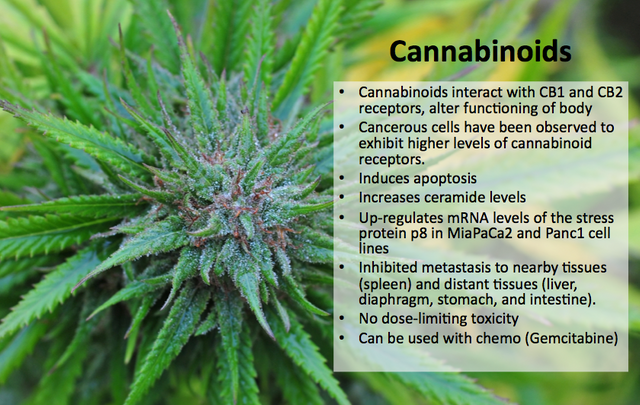
The three therapies put forth offer viable and affordable alternatives for the treatment of pancreatic cancer. Given the generally low success rates of conventional methods, turmeric, Huachansu, and medical cannabis have the potential to serve as primary forms of treatment and/or be used in combination with conventional methods without adverse effects. It is plausible that the use of Huachansu and medical cannabis will increase as additional research relating to viability in humans unfolds.
References:
(1)Key Statistics for pancreatic cancer. wwwcancerorg. 2016. Available at: http://www.cancer.org/cancer/pancreaticcancer/detailedguide/pancreatic-cancer-key-statistics. Accessed April 6, 2016.
(2) Prognosis of Pancreatic Cancer-Pancreatic Cancer. Pancreaticorg. 2016. Available at: http://www.pancreatic.org/site/c.htJYJ8MPIwE/b.891917/k.5123/Prognosis_of Pancreatic_Cancer.htm. Accessed April 6, 2016.
(3) Whipple Procedure: Effects, Success Rate, and More. WebMD. 2016. Available at: http://www.webmd.com/cancer/pancreatic-cancer/whipple-procedure. Accessed April 6, 2016.
(4) Pancreatic Cancer Prognosis, Pancreatic Cancer Survival, Pancreas Cancer Prognostic, Pancreatic Cancer Mortality | Monterey, San Jose, San Francisco, Los Angeles, San Diego | Cancer Patients Alliance. Pancreatica. 2016. Available at: http://pancreatica.org/faq/pancreatic-cancer-prognosis/. Accessed April 6, 2016.
(5) Hazard L. The Role of Radiation Therapy in Pancreas Cancer. Gastrointestinal Cancer Research : GCR. 2009;3(1):20. Available at: http://www.ncbi.nlm.nih.gov/pmc/articles/PMC2661119/. Accessed April 6, 2016.
(6) Mehta D. Ayurveda & Cancer. PD Ayurveda Today. 2016. Available at: http://pdayurvedatoday.com/ayurveda-and-cancer.pdf. Accessed April 6, 2016.
(7) A Vision of Cancer From an Ayurvedic Perspective - Vaidya Atreya Smith. Atreyacom. 2016. Available at: http://www.atreya.com/ayurveda/A-Vision-of-Cancer-From-an.html. Accessed April 6, 2016.
(8) DÃaz Osterman C, Gonda A, Stiff T, Sigaran U, Valenzuela M, Ferguson B. Curcumin Induces Pancreatic Adenocarcinoma Cell Death Via Reduction of the Inhibitors of Apoptosis. - PubMed - NCBI. Ncbinlmnihgov. 2016. Available at: http://www.ncbi.nlm.nih.gov/pubmed/26348467. Accessed April 6, 2016.
(9) Gallant L. Turmeric: “The Golden Goddess” | CA College of Ayurveda. Ayurvedacollegecom. 2016. Available at: https://www.ayurvedacollege.com/articles/students/turmeric. Accessed April 6, 2016.
(10) Kanai M, Otsuka Y, Otsuka K, Sato M, Nishimura T, Mori Y. A phase I study investigating the safety and pharmacokinetics of highly bioavailable curcumin (Theracurmin) in cancer patients. - PubMed - NCBI. Ncbinlmnihgov. 2013. Available at: http://www.ncbi.nlm.nih.gov/pubmed/23543271. Accessed April 6, 2016.
(11) Goel A, Kunnumakkara A, Aggarwal B. Curcumin as “Curecumin”: From kitchen to clinic. Biochemical Pharmacology. 2008;75(4):787-809. doi:10.1016/j.bcp.2007.08.016.
(12) Lev-Ari S, Starr A, Vexler A, Karauch V, Loew V, Grief J. Inhibition of Pancreatic and Lung Adenocarcinoma Cell Survival by Curcumin is Associated with Increased Apoptosis, Down-regulation of COX-2 and EGFR and Inhibition of Erk1/2 Activity. NCBI. 2006. Available at: http://www.ncbi.nlm.nih.gov/pubmed/17201164. Accessed April 6, 2016.
(13) Dhillon N. Phase II trial of curcumin in patients with advanced pancreatic cancer. - PubMed - NCBI. Ncbinlmnihgov. 2008. Available at: http://www.ncbi.nlm.nih.gov/pubmed/18628464. Accessed April 6, 2016.
(14) Traditional Chinese medicine (TCM) | Cancer Research UK. Cancerresearchukorg. 2015. Available at: http://www.cancerresearchuk.org/about-cancer/cancers-in- general/treatment/complementary-alternative/therapies/traditional-chinese-medicine. Accessed April 6, 2016.
(15) Cancer & Traditional Chinese Medicine - Cancer Treatment and Care - HealthCommunities.com. Healthcommunitiescom. 2015. Available at: http://www.healthcommunities.com/cancer-treatment-and-care/ alternative-medicine/traditional-chinese-medicine-and-cancer.shtml. Accessed April 6, 2016.
(16) Dharmananda S. Oriental Perspectives on Cancer and Its Treatment. Itmonlineorg. 1997. Available at: http://www.itmonline.org/arts/cancer.htm. Accessed April 6, 2016.
(17) Zang-Fu | Oriental Medicine. Orientalmedicinecom. 2016. Available at: http://www.orientalmedicine.com/zang-fu. Accessed April 6, 2016.
(18) Meng Z, Shen Y, Yang P. Pilot study of huachansu in patients with hepatocellular carcinoma, nonsmall-cell lung cancer, or pancreatic cancer. - PubMed - NCBI. Ncbinlmnihgov. 2009. Available at: http://www.ncbi.nlm.nih.gov/pubmed/19701908. Accessed April 6, 2016.
(19) Fanghua Q, Anyuan L, Kokudo N. Antitumor activity of extracts and compounds from the skin of the toad Bufo bufo gargarizans Cantor. Sciencedirectcom. 2011. Available at: http://www.sciencedirect.com/science/article/pii/S1567576910004108. Accessed April 6, 2016.
(21) Meng Z, Garrett C, Shen Y, Liu L. Prospective randomised evaluation of traditional Chinese medicine combined with chemotherapy: a randomised phase II study of wild toad extract plus... - PubMed - NCBI. Ncbinlmnihgov. 2012. Available at: http://www.ncbi.nlm.nih.gov/pubmed/term=huachansu%2C+pancreatic+cancer%2C+gemcitabine. Accessed April 6, 2016.
(22) Kurzrock R. Phase I Study of HuaChanSu in Hepatocellular Carcinoma, Non-Small CellLung Cancer, and Pancreatic Cancer. Mdandersonorg. 2016. Available at: https://www.md anderson.org/patients-family/diagnosis-treatment/clinical-trials/clinical-trials-index/clinical-trials-detail.ID2004-0685.html. Accessed April 6, 2016.
(23) Garrett C. A Randomized, Placebo-controlled, Blinded Phase II Study of Huachansu&Gemcitabine in Pancreatic Cancer. Mdandersonorg. 2016. Available at: https://www.mdanderson.org/patients-family/diagnosis-treatment/clinical-trials/clinical-trials-index/clinical-trials-detail.ID2006-0948.html. Accessed April 6, 2016.
(24) What Causes Pancreatic Cancer?. Pathologyjhuedu. 2015. Available at:http://pathology.jhu.edu/pc/BasicCauses.php?area=ba. Accessed April 6, 2016.
(25) What the Science Says. Americans for Safe Access. 2016. Available at: http://www.safeaccess now.org/medical_cannabis_research_what_does_the_evidence_say. Accessed April 6, 2016.
(26) Marinol oral : Uses, Side Effects, Interactions, Pictures, Warnings & Dosing - WebMD. WebMD. 2016. Available at: http://www.webmd.com/drugs/2/drug-9308/marinol- oral/details. Accessed April 6, 2016.
(27) Benefits of CBD Get National Attention, Study | California NORML. Canorml.org. 2016. Available at: http://www.canorml.org/cbd.html. Accessed April 6, 2016.
(28) News and Facts On Cannabinoid Receptors - Leaf Science. Leaf Science. 2016. Available at: http://www.leafscience.com/endocannabinoid-system/works/cb1-cb2-receptors/. Accessed April 6, 2016.
(29) Medical Marijuana For Pancreatic Cancer?. TruthOnPotcom. 2013. Available at: http://www.truthonpot.com/2013/04/14/medical-marijuana-for-pancreatic-cancer/. Accessed April 6, 2016.
(30) Carracedo A. Cannabinoids induce apoptosis of pancreatic tumor cells via endoplasmic reticulum stress-related genes. - PubMed - NCBI. Ncbinlmnihgov. 2006. Available at: http://www.ncbi.nlm.nih.gov/pubmed/16818650. Accessed April 6, 2016.
(31) Michalski C, Oti F, Erkan M et al. Cannabinoids in pancreatic cancer: Correlation with survival and pain. International Journal of Cancer. 2008;122(4):742-750.doi:10.1002/ijc.23114.
(32) Donadelli M, Dando I, Zaniboni T et al. Gemcitabine/cannabinoid combination triggers autophagy in pancreatic cancer cells through a ROS-mediated mechanism. Cell Death Dis. 2011;2(4):e152. doi:10.1038/cddis.2011.36.
(33) State Marijuana Laws Map. Governing.com. 2016. Available at: http://www.governing.com/gov-data/state-marijuana-laws-map-medical-recreational.html. Accessed April 6, 2016.
Image References:
(1) Image: turmeric-fluoride-protection.jpg
Page: theeventchronicle.com
(2) Image: info/infoRF.aspx
Page: amanaimages.com
(3) Image: marijuana-cannabis-leaf-green-735-3501.jpg
Page: naturalsociety.com
(4) Image: 2-113845724.jpg
Page: asiancancer.com
(5) Image: P1010930-620x411.jpg
Page: blacklemag.com
(6) Image: US08802637-20140812-C00012.png
Page: patents/US8802637
(7) Image: 5lack_250_175.jpg
Page: nature.health-ua.org
(8) Image: online/Chinese-Herbs-3044682.aspx
Page: www.featurepics.com
(9) Image: HuaChanSu-sls.jpg
Page: www.onlymyhealth.com
(10) Image: toadskin.jpg
Page: www.californiaherps.com
(11) Image: 201210178595.jpg
Page: www.mruan.com
(12) Image: 330x330_0FE.jpg
Page: www.taringa.net
(13) Image: big_bud.jpg
Page: www.cannaceutics.org
(14) Image: 2000px-Tetrahydrocannabinol.svg.jpg
Page: distinctlyoklahoma.com
(15) Image: marijuana.jpg
Page: www.travelweekly.com
Highly informative, thank you @brookeloving I'm sorry for your loss but impressed and heartened by your response. I don't know much about all the science but I guess if one is dying anyway, better to try turmeric than nuking your entire immune system with radiation or chemo (which by the way has a 97% failure rate) I'm saddened by the aggression and derision expressed by others on this post. Keep up the positivity Brooke. Followed
Thank you @handsolo! I really appreciate it.
hi @brookeloving, I love your article, because I'm campaigning about cancer in my place, thx for sharing
Very well written. Thank you for posting. I try to follow natural remedies. ~Cheers~
https://steemit.com/@james83501
What a crazy disease I ever saw.
This post has been linked to from another place on Steem.
Learn more about linkback bot v0.4. Upvote if you want the bot to continue posting linkbacks for your posts. Flag if otherwise.
Built by @ontofractal
I'm annoyed by so much pseudoscience trending on Steemit. If this shit worked Steve Jobs would be alive. He tried this with all the money on earth.
I don't understand how this post got so much reward. These are facts mixed with mumbo jumbo.
Non of the sources provided in the article point to any coherent scientific research and data supporting any of that information, except of some sources about huachansu.
Ayurvedic medicine in based on obsolete knowledge, mostly based in pseudoscience. Designed by ancient society who had poor scientific understanding.
Chinese medicine. Most of Chinese medicine is bullshit too. A lot of it is very dangerous and a lot of it is completely retarded and ecocidal (like rhino horn powder, tiger penis medicaton etc).
Very small percent of it is proven to show some efficacy like huachansu.
Marihuana claims. Myths, incomplete data and scientific confusionism.
http://scienceblogs.com/insolence/2015/06/24/does-medical-marijuana-work-the-answer-is-mostly-no-and-we-dont-know/
Most of SteemSTEM members have almost dropped into coma reading this.
I respect your opinion @logic, and I stand by my work. I invite you to read my entire article as well as read the studies I cited (see references below). I am sure that the studies will give much more scientific detail than my preliminary undergraduate research. Ultimately, in my conclusion I propose that these therapies can be used in conjunction with allopathic medicine (i.e. chemo, radiation, surgical removal) because turmeric, huachansu, and cannabis, when tested, have possessed no dose-limiting toxicity. Thank you for taking the time to offer feedback. Brooke
I think i might be the one that got away.
They caught my Tumor just before it turned Cancerous...
Now i.m just left with Pancreatitis
Great ...truth is slowly reveling
https://steemit.com/health/@vox00/cancer-cells-cannot-live-in-alkaline-tissues
I wrote these article a week back
Peace